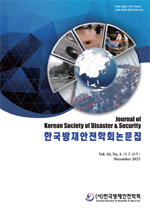장마와 같이 장기간에 내리는 강우나 단기간에 많은 양의 강우가 내리는 집중호우의 영향으로 산사태, 토석류와 같은 산지재해가 발생한다. 산사태와 토석류는 인적, 물적 피해를 야기하므로 이를 예방하기 위한 다양한 대책의 적용과 연구가 수행되고 있다. 토석류 재해 연구 중 토석류 수치모형은 비교적 간단하게 연구지역에 대한 위험도를 분석할 수 있다. 다만 경험에 의한 방정식이 적용되어 모형마다 다른 결과를 나타내고 입력변수도 모델마다 차이가 있어 수치모형의 검증은 필수적이다. 본 연구에서는 토석류 수치모형을 이용하여 토석류의 피해를 저감하기 위한 시설인 사방댐과 종단구조물인 계간수로를 반영하여 이에 따른 저감효과를 비교 ‧ 분석하였다.
The impact of prolonged rainfall, such as during the monsoon season or intense concentrated rainfall over a short period, can lead to mountainous disasters such as landslides and debris flows. These events, such as landslides and debris flows, cause both human and material damage, prompting the implementation of various measures and research to prevent them. In the context of researching debris flow disasters, numerical models for debris flows provide a relatively simple way to analyze the risk in a study area. However, since empirical equations are applied in these models, yielding different results and variations in input variables across models, the validation of numerical models becomes essential. In this study, a numerical model for debris flows was employed to compare and analyze the mitigation effects of facilities such as check dams and water channel work, aiming to reduce the damage caused by debris flows.
1. 서론
2. 연구방법
3. 토석류 수치모형 적용
4. 수치해석 및 결과분석
5. 결론
Acknowledgments
References
